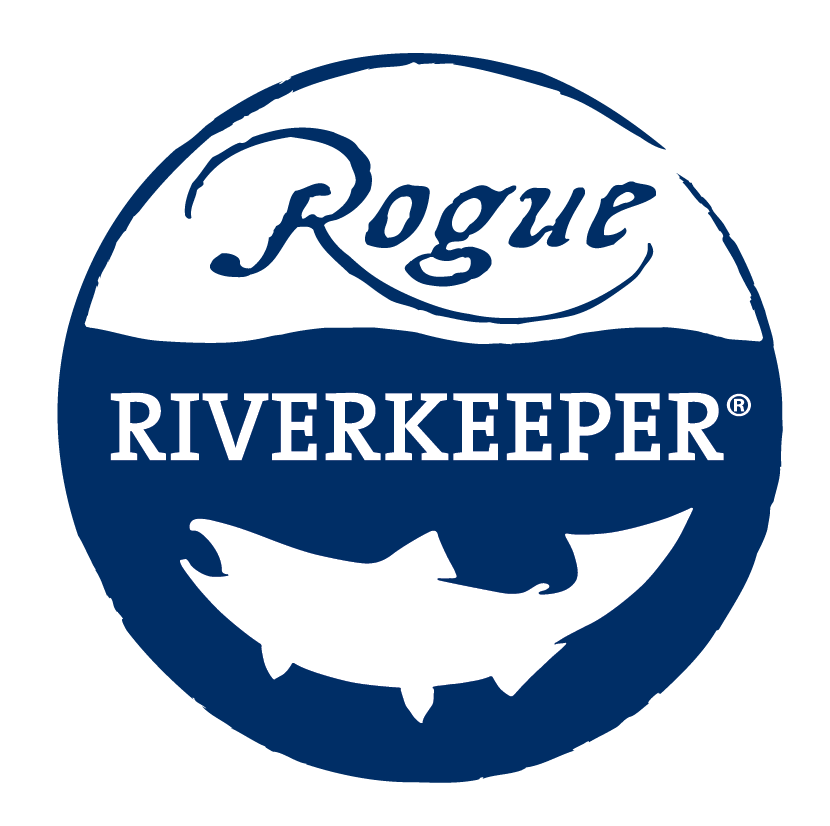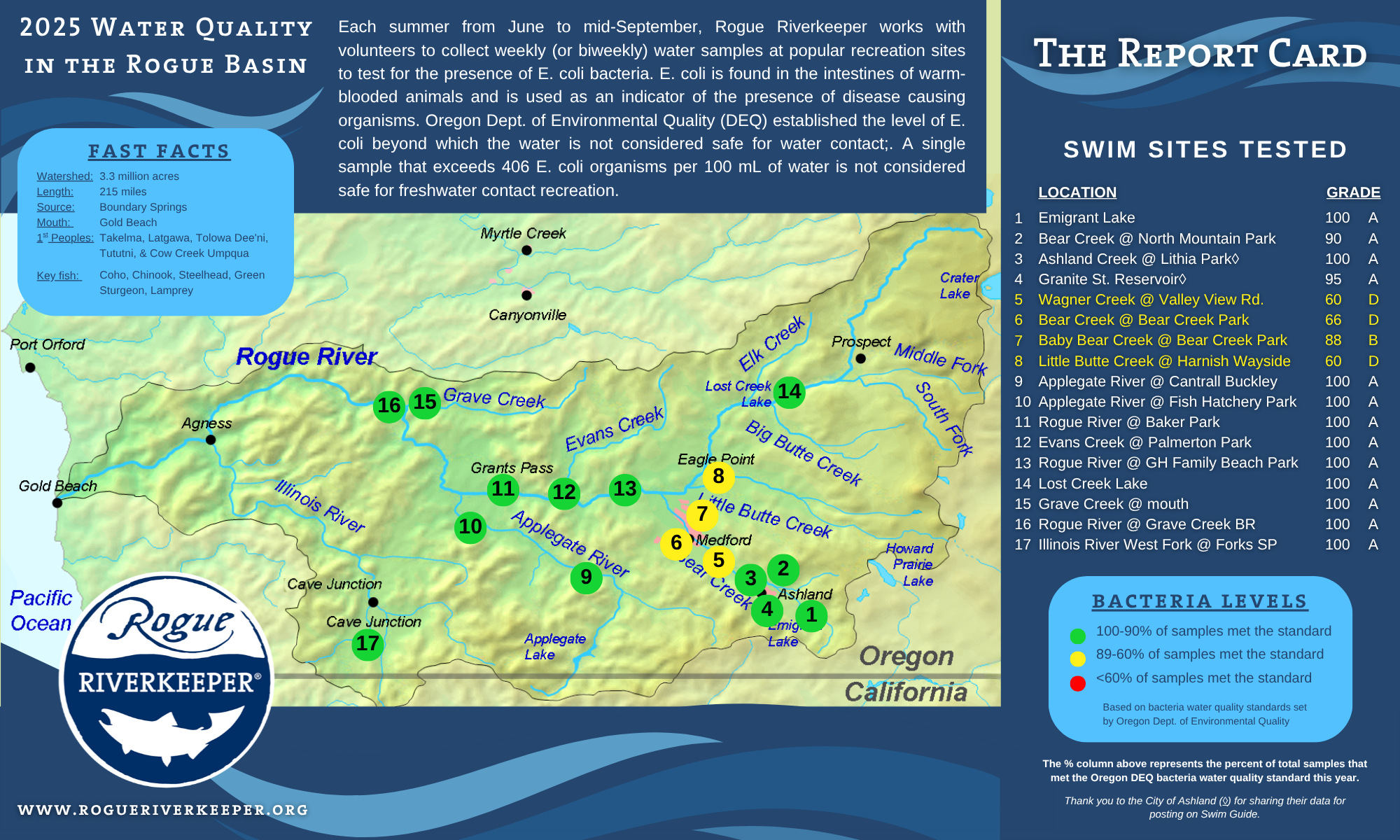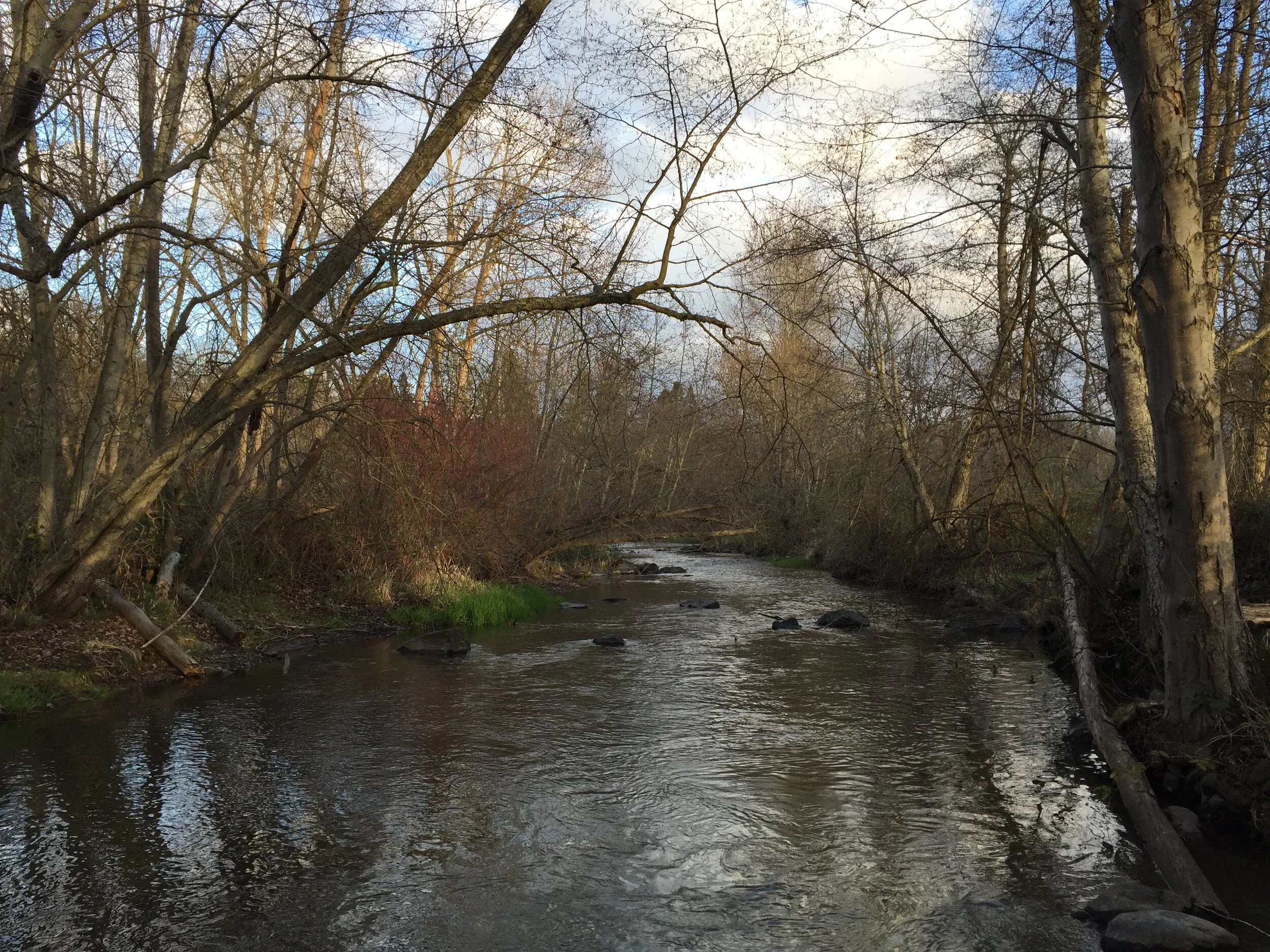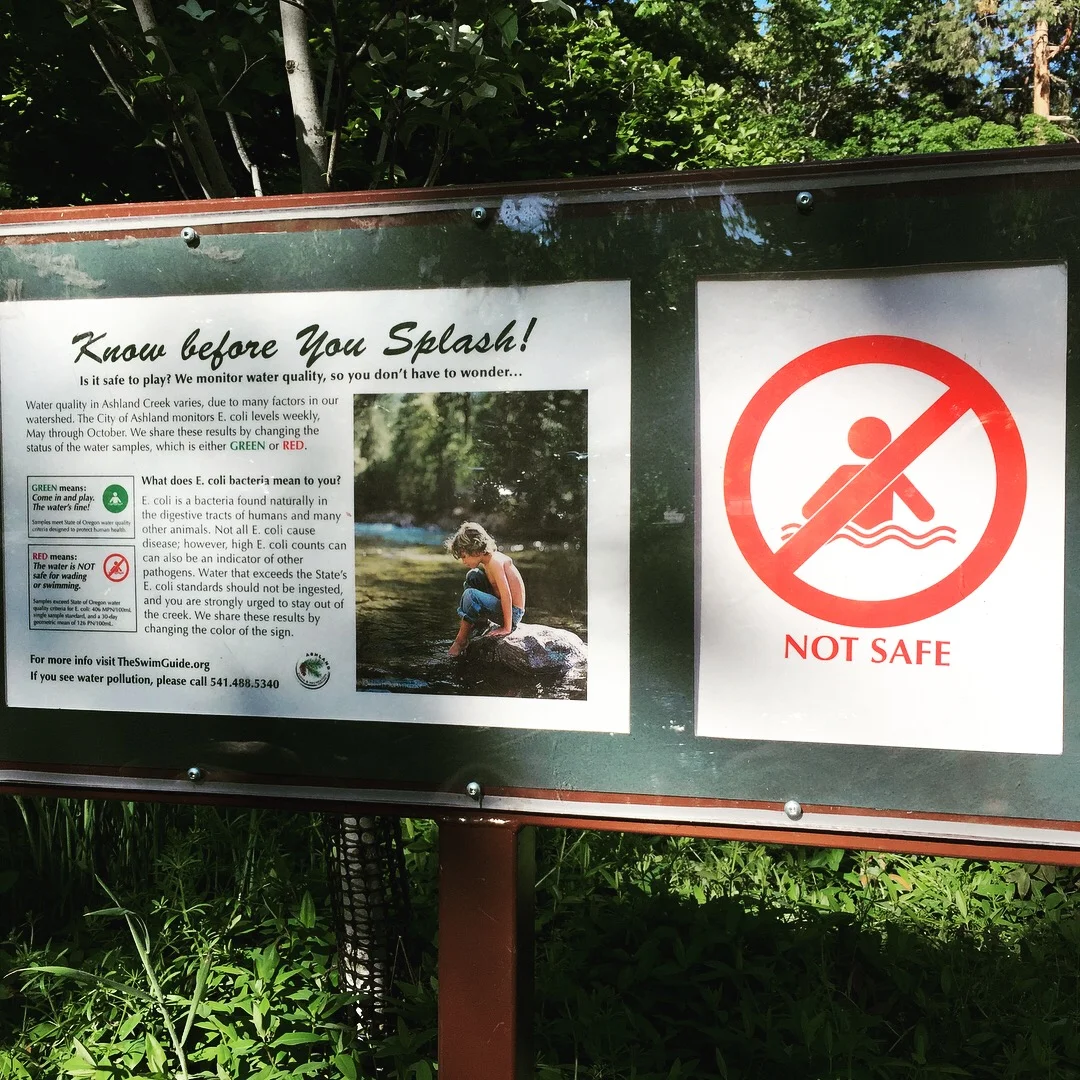The Swim Guide
Have you ever wondered if your favorite stream, lake, or swimming hole is safe for swimming?
You can easily check to see if some of your favorite swimming and boating spots meet the recreational water quality standard at our Swim Guide page.
Each summer, Rogue Riverkeeper works with volunteers to collect water samples at popular recreation sites across the region to test for bacterial contamination. We compare the level of bacteria at our sampling sites with the Oregon recreational water quality standard to see if local waterways are violating the standard for water contact.
2025 Water Quality Monitoring
We spent the summer of 2025 monitoring 17 important waterways across the Rogue basin, and we’re pleased to see that many of our favorite recreation sites are safe for swimming, fishing, and boating! Standout locations continue to be the main stem of the Rogue in several locations from Gold Hill to the Grave Creek boat ramp, the West Fork Illinois at Forks State Park, and Applegate Rivers at Cantrall-Buckley and Fish Hatchery Parks, Ashland Creek in Lithia Park, Grave Creek at the mouth and Evans Creek at Palmerton Park in the City of Rogue River.
However, problems persist for a few local sites…
Two tributaries, Wagner Creek and Little Butte Creek, had regular incidence of E. coli bacteria. While these streams are not commonly used for swimming and boating because they are too small and fishing is not allowed, they both flow alongside residences and parks. These streams are shallow and easily accessible by residents and could be a safe place for recreation in the summer if not for the high incidence of bacteria. Wagner Creek flows through Talent, and Little Butte Creek flows through Eagle Point, and only 60% of samples we collected from those streams passed the standard for safe water contact this summer.
While Lost Creek Lake and Emigrant Lake had low bacteria this summer, both had issues with harmful algal blooms and saw an advisory from the OR Health Authority in the early summer. Sampling done by Rogue Riverkeeper and posted on Swim Guide only indicates the incidence of E. coli bacteria, which is what Oregon uses to determine that water is safe for contact, but there are other substances, like harmful algal blooms or other contaminants that can make water unsafe for swimming. Always use caution and if in doubt, stay out.
Scroll through the story of the 2025 Water Quality season!
What do we test for?
We collect water samples at each site and test for the presence of E. coli, a type of bacteria that is found in the intestines of warm-blooded animals. Levels of E. coli are used as the standard because E. coli indicates the presence of pathogens that can cause gastrointestinal illnesses and make people sick.
Where do we test?
We monitor water quality throughout the summer (June through September) at approximately 20 different sites throughout the Rogue basin. Rogue Riverkeeper works with citizen science volunteers and coordinates with partners including the City of Ashland and the Lower Rogue Watershed Council to collect water samples at all of our sites. Many of our sites are monitored weekly, so check in with Swim Guide to stay up-to-date on current conditions.
What do the results mean?
After collecting and processing the water samples, we compare the measured level of E. coli with the Oregon recreational water quality standard. This is a limit on the amount of bacteria that can be in a river or stream that is established by the Oregon Department of Environmental Quality (DEQ) based on the advice of scientists to protect public health. If the sample surpasses the standard, it is not considered safe for water contact like swimming and boating.
Download the Swim Guide app to check the water quality of your summer swimming site!
Dive into previous years’ Report Cards below
-
During our 2024 water quality testing, most sites across the Rogue basin that were tested had minimal signs of fecal contamination, but two streams stand out for frequent bacterial contamination.
Wagner Creek, which flows through Talent, and Little Butte Creek, which flows through Eagle Point, both had less than 65% of their samples pass the standard for safe water contact this summer. Both streams have rural residential and agricultural land upstream. After Rogue Riverkeeper’s sampling, several other agencies followed up with further sampling of Wagner Creek upstream of the town of Talent and found high levels of bacterial contamination, indicating that the bacteria is entering into the creek before Wagner Creek enters town. Rogue Riverkeeper is working with partners and the OR Dept. of Environmental Quality to determine the source of the pollution in Wagner Creek.
-
2023 was overall a decent year for water quality despite one site: Little Butte Creek in Eagle Point. Pollution origins are unknown, but its likely to result from agricultural runoff from upstream sources.
-
This year’s results show a continuous pattern in our region. Usually, the main arm of the Rogue River has water that is safe for swimming. This is largely because it receives a lot of dilution by high-quality water from surface sources (such as streams) and groundwater (such as springs and wetlands). However, there are many small streams in our region that regularly have high levels of bacterial contamination.
Click here to see our full report card for the 2022 collection season.
-
As drought conditions continue to worsen year after year, it is more important than ever to pay attention to water quality and quantity in select sensitive waterways in the Rogue Valley. In 2021, many sites measured passed, but a few popular sites did not pass. Click here or here to see the 2021 Water Quality Report Card.
-
The Rogue Basin Water Quality Report Card highlights the results of our 2020 water quality monitoring program where we tested for bacteria pollution across 14 sites in the Rogue watershed. Every summer from June to September, Rogue Riverkeeper collects water samples at popular recreation sites to test for the presence of E. coli bacteria to determine whether the samples meet the state water quality standard for human contact. The information is uploaded onto The Swim Guide site each week, so you can check the water quality at your favorite recreation sites. Click here to see the full 2020 Water Quality Report Card.
-
The Report Card highlights the results of the 2019 water quality monitoring season testing for bacteria pollution across 22 sites in the Rogue watershed. While the majority of sites tested reveal waters safe for human contact, we monitored several sites that either failed to meet water contact standards or performed below average. Waterways that tested high for levels of E. Coli bacteria contamination were most often close to urban areas - these sites include Little Butte Creek through Eagle Point, Bear Creek and Baby Bear Creek at Bear Creek Park, and Wagner Creek in Talent. Click here to see a full report of the 2019 water quality monitored.
We need volunteers!
We are always in need of volunteers to help us with our water quality program. If you love to visit your local waterways, have some free time during the summer, and are interested in learning more about water quality issues in the Rogue Basin, volunteer today!

















